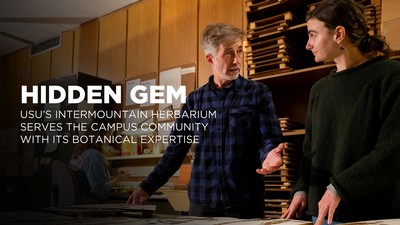USU Physics Student Excels in International Satellite Competition
Utah State University graduate physics student Ryan Hoffmann took the top prize in an international student competition at the 22nd Annual Small Satellite Conference Aug. 11-14 at USU.
A participant in the 16th Annual Frank J. Redd Student Scholarship Competition, Hoffmann presented “Low-Fluence Electron Yields of Highly Insulating Materials.” He tied for first place with Daniel Kwon, a student at the Massachusetts Institute of Technology, who presented “Cryogenic Thermal Design of Small Electromagnetic Formation Flight Satellites.”
Hoffmann and Kwon each received $10,000 scholarships.
“This is the first time we’ve ever had a tie for first,” says Jaimie Kandler, conference administrator at USU’s Space Dynamics Laboratory, host of the event. “The competition was intense and our judges were very impressed the high quality of the student papers and presentations.”
Second place and a $5,000 scholarship went to Rashied Amini of Washington University in St. Louis. Takaya Inamori of the University of Tokyo placed third and received a $3,000 scholarship.
Honorable mentions were awarded to Marit Meyer of Washington University and to Tyson Smith, a mechanical and aerospace engineering student at USU. Each received a $1,500 scholarship.
The six awardees were selected as finalists based on papers they submitted in advance of the conference and all were invited to present their research at the conference. More than 40 undergraduate and graduate students, from universities throughout the nation and abroad, submitted papers. Finalists were selected by a panel of judges representing academia, industry and governmental organizations. Scholarship funds were donated by individuals and aerospace companies.
Hoffmann’s research, which he conducts with USU physics professor J.R. Dennison, involves developing ways to predict how varied materials will perform in space. Spacecraft and astronauts are subjected to punishing solar weather in space, he says, which presents serious hazards.
“When you scuff your feet across the carpet, you charge up,” Hoffmann says. “In a similar way, spacecraft travel through a big soup of charged particles that can cause them to charge up and malfunction.”
In the lab, Hoffmann and colleagues use a vacuum chamber to blast a variety of material samples — including ceramics and metals — with specific frequencies of light. They measure the resulting current from electrons emitted by each material.
Their research, funded by NASA, could help determine materials that will be used in the construction of the agency’s James Webb Space Telescope — planned successor to the Hubble, the Solar Probe and spacecraft to be constructed for future lunar and Mars missions.
The late Frank J. Redd, former deputy director of SDL and professor of mechanical and aerospace engineering at USU, founded the small satellite conference and the student scholarship competition, which was renamed in his honor in 2002.
“Dr. Redd thought of himself primarily as an educator, so it’s a fitting tribute that the student scholarship competition bears his name,” Kandler says.
Related links:
- “Lessons from Icarus,” Utah State Today
- Space Dynamics Laboratory
- USU Physics Department
- USU College of Science
Contact: Ryan Hoffman, ryanphyx@gmail.com
Contact: J.R. Dennison, (435) 797-2936, jr.dennison@usu.edu
Writer: Mary-Ann Muffoletto, (435) 797-3517, maryann.muffoletto@usu.edu
Contact: J.R. Dennison, (435) 797-2936, jr.dennison@usu.edu
Writer: Mary-Ann Muffoletto, (435) 797-3517, maryann.muffoletto@usu.edu
USU physics graduate student Ryan Hoffmann placed first in the student competition at the 2008 AIAA/USU Small Satellite Conference. He tied with MIT student Daniel Kwon.
TOPICS
Satellites 67storiesComments and questions regarding this article may be directed to the contact person listed on this page.






